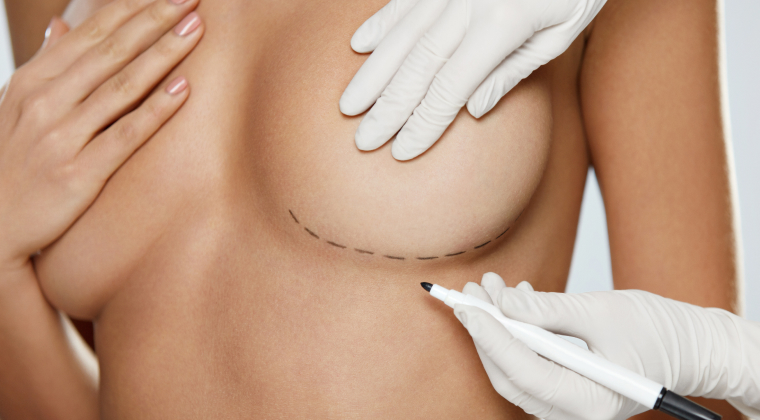Breast Augmentation
Surgical Procedure
During breast augmentation, a breast implant is placed either under the breast tissue and over the chest muscle, or under both the chest muscle and the breast tissue. Your surgeon will advise you on the most suitable procedure for you. This helps to increase or balance the size of the breasts, restore breast volume, or restore the shape of breasts after partial or total loss. Please note that breast augmentation cannot correct significantly sagging or drooping breasts. In these instances, a breast lift is often necessary, which may be performed in conjunction with this procedure.
All breast implants are made with a silicone based casing but they are filed with either silicone gel or saline. The outer silicone case may be smooth, shiny, polished, or a slightly rough texture. The type, style, and size of breast implants you choose are determined by your lifestyle, body contours, the amount of breast tissue you have, and the cup size and appearance that you would like to achieve. You should talk to your doctor about choosing the breast implant option that is right for you
We offer the most commonly used methods of incision and insertion; at the nipple, under the breast or under the armpit and it may be more than a simple case of aesthetics as to which option is chosen. Your surgeon will advise you of best procedure to suit you.
1 NIGHT
2 - 3 HOURS
GENERAL ANAESTHESIA
Pre Operative Care
When assessing the size and placement of the implant our aim is to augment your breasts in proportion with your body and to maintain a natural look. The size and placement of the implant chosen depends on many factors, such as your cup size, your desired cup size, your build, including chest muscle tone. If you have a small amount of breast tissue and want to augment as much as possible, it is recommended that a large implant is placed below the muscle, in order to prevent the feeling or appearance of the implant. There is also less chance of capsular contracture (hardening). If you have large chest muscles the implant should be placed above the muscles in order to allow for comfortable movement and a natural look. For patients with mild to moderate breast sagging, a larger implant placed over the muscle is recommended. This enables a full and natural augmentation.
 Inform your surgeon of any allergies, all medical conditions, and any medication that you are taking (both prescription and non-prescription).
Inform your surgeon of any allergies, all medical conditions, and any medication that you are taking (both prescription and non-prescription). Avoid aspirin and blood thinning medication such as brufen for two weeks prior to surgery to eliminate the chance of post op. bleeding.
Avoid aspirin and blood thinning medication such as brufen for two weeks prior to surgery to eliminate the chance of post op. bleeding.  You should not smoke for 2 weeks prior to surgery as this may affect your reaction to the anaesthetic and prolong the healing process.
You should not smoke for 2 weeks prior to surgery as this may affect your reaction to the anaesthetic and prolong the healing process.  Patients that suffer from hypertension must inform the surgeon prior to surgery.
Patients that suffer from hypertension must inform the surgeon prior to surgery.Package Price

Post Operative Care
When assessing the size and placement of the implant our aim is to augment your breasts in proportion with your body and to maintain a natural look. The size and placement of the implant chosen depends on many factors, such as your cup size, your desired cup size, your build, including chest muscle tone. If you have a small amount of breast tissue and want to augment as much as possible, it is recommended that a large implant is placed below the muscle, in order to prevent the feeling or appearance of the implant. There is also less chance of capsular contracture (hardening). If you have large chest muscles the implant should be placed above the muscles in order to allow for comfortable movement and a natural look. For patients with mild to moderate breast sagging, a larger implant placed over the muscle is recommended. This enables a full and natural augmentation. Inform your surgeon of any allergies, all medical conditions, and any medication that you are taking (both prescription and non-prescription). Avoid aspirin and blood thinning medication such as brufen for two weeks prior to surgery to eliminate the chance of post op. bleeding. You should not smoke for 2 weeks prior to surgery as this may affect your reaction to the anaesthetic and prolong the healing process. Patients that suffer from hypertension must inform the surgeon prior to surgery.
Risks and Complications
Since 2000, statistics show that a low number of silicone or saline implant recipients have experienced complications.Capsular contracture occurs if the capsule, or shell, around the implant begins to tighten and thicken. This will cause the breast to feel hard and appear unnatural. Preventing this can be best achieved by regular self-massage. Your surgeon will advise you on just how to do this. Should a problem arise, there are a number of ways to correct the issue. Sometimes removal of the capsule is required, or perhaps the implant may need to be replaced, however this is uncommon if you follow your surgeon’s directions.
If a breast does become infected or deflated, the implant must be removed immediately. You will need to wait several months before repeating the operation.
Despite bleeding generally being minimal during the operation, there is a possibility that continual bleeding after surgery may result in a blood clot – which would need to be removed. This is uncommon and it is suggested you remain in Thailand for approximately 2 weeks for your surgeon to monitor your improvement after surgery. Infection is uncommon, but possible. Your surgeon should provide you with antibiotics prior to surgery to eliminate this possibility. A reputable accredited surgeon will perform these procedures to eliminate risk.
Detecting breast cancer may be more difficult.
Results
Breast augmentation increases breast size which can enhance your self esteem and confidence. The procedure will leave you with a better figure and help to balance your body proportions. For many women, including those who may have undergone a mastectomy, child birth or weight loss, you will notice a magnificent improvement and initial scarring will gradually fade.
In 2000, both Silicone and Saline implants were both approved by U.S. health officials. Implants manufactured by Inamed and Mentor – the two leading marketers of implants – were considered safe and effective for continued use.



